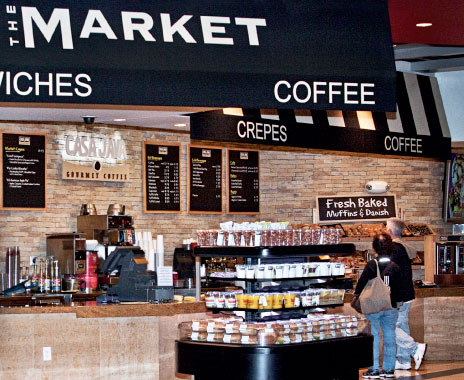Forget the classic buffet of stale, day-old fare once prevalent in America’s casinos. The dining landscape in these establishments is now just as competitive and diverse as the world beyond blackjack tables and slots. In casinos, excess is everywhere. People expect an array of choices for gambling, entertainment, and, of course, food. That’s why several quick-service operators are investing in the space.
“Casinos have to have options,” says Corey Nyman, a restaurant consultant with Las Vegas–based The Nyman Group. “Casinos know they need to step up their game because they need to keep their players in the building that much longer.”
It’s easy to equate casinos with the Las Vegas strip, but Nyman says restaurateurs should think of Vegas as an anomaly, not the norm. A hotel operator at a location with 100 rooms and two restaurants in mid-America will have to run things differently than an operator in Vegas. In Sin City, tourists are mobile. They hop from one casino to the next.
“Most of them are in Vegas for unique experiences that they can’t get at home and will actively seek those opportunities out,” says Anthony Carron, chef and co-creator of 800 Degrees Neapolitan Pizzeria, which opened locations in both the Monte Carlo Resort and Casino and the SLS Las Vegas Hotel & Casino this year. “It’s a highly dense market where every person is eating 100 percent of their meals out, and the guests are generally there because they want to be happy, which makes guest service fun.”
For casinos in other cities, the market is more captive. Casinos are often standalone destinations, where customers may stay for several days at a time. But the competition for restaurants to get in—and the fight for customers once there—is still fierce. And unlike airports or other nontraditional locations where convenience may be king, casinos are all about the experience. Buffets and steakhouses still exist in many locations, but dining opportunities are growing more diverse.
“[Consumers] go to these places to feel good. Yes, they want to win money. But it’s more of a feeling they have when they’re there,” Nyman says. “You’re giving them this hope, whether it’s false, real, or imagined.”
There are more than 30 dining options in Connecticut’s Mohegan Sun Casino, including big names like Bobby Flay’s Bar Americain and Michael Jordan’s Steak House. Without the novelty of a celebrity name, Ballo Italian Restaurant has to leverage itself on high-quality menu items at prices lower than fine dining, says Ballo’s general manager, Jason Barlow.
He says casino customers crave a high-quality experience at a fast pace. Even though there are free drinks on the gambling floor, Ballo sells specialty cocktails and Italian wines.
“There’s more of demand for fast, outstanding service and food,” Barlow says. “People want to sit down and be served. … That’s part of being entertained when you’re in such a grandiose environment.”
At the Mohegan Sun, one of the top-grossing casinos in the U.S., dining traffic often revolves around shows and concerts in the 10,000-seat arena. Oftentimes, concertgoers are looking to eat dinner within a two-hour window of their show, putting restaurants on the spot to turn tables quickly.
While glitzy restaurants and celebrity-backed offerings do big business in casinos, operators say there’s still plenty of room for limited-service concepts, usually in food-court settings.
“People absolutely want a fast-casual option. They want quality food quickly in a casino,” says Fatburger CEO Andrew Wiederhorn. “Because they don’t really want to spend time at the dining area. They want to be gambling or at a show.”
Fatburger operates in about a dozen casino locations. While customers probably aren’t going to casinos for the quick-service or fast-casual food, there’s still plenty of potential to make a play at convenience and quality, Wiederhorn says. He adds that the main key to success is learning to leverage the existing casino patron and understanding how to differentiate the menu and service to provide something not already there.
Casinos see lots of foot traffic at all hours of the day. That dynamic might make staffing more difficult, but it also opens up more potential. Wiederhorn says business is strong because of the multiple dayparts, and late-night traffic offers ample opportunities.
Like at airports and other nontraditional locations, casinos’ culinary offerings continue to grow in sophistication, says Adam Torine, senior vice president of business development at Villa Enterprises Management, which operates in about 20 casino food courts. While business is strong in casinos, Torine says, the competition is tough and constantly changing. Villa is constantly working beyond its four walls to increase its casino business, whether through catering opportunities, running its own promotions, or catering to local casino employees.
“It’s not necessarily the environment [that ensures success]—although you have to manage the peaks and valleys of the business and staff accordingly—but truly understanding who the customer is at that particular casino and how to tailor your menu options and pricing are key,” Torine says.







